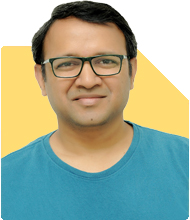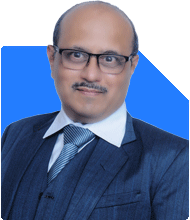Ramalingam Kalirajan |10894 Answers |Ask -Follow
Mutual Funds, Financial Planning Expert - Answered on May 23, 2024
He has an MBA in finance from the University of Madras and is a certified financial planner.
He is the director and chief financial planner at Holistic Investment, a Chennai-based firm that offers financial planning and wealth management advice.... more

I am retired now, I have 2 cores wt can I do monthly income. No burdens.own home. My age 53.
Congratulations on your retirement and your substantial savings of 2 crores. Your prudent financial management and owning a debt-free home are commendable achievements.
Assessing Your Financial Goals and Risk Tolerance
Financial Goals
Your main goal is to generate a steady monthly income from your savings. Additionally, you might want to consider preserving and growing your capital.
Risk Tolerance
As a retiree, it's crucial to balance generating income with preserving your capital. Your risk tolerance might be moderate, focusing on stability with some growth.
Investment Options for Monthly Income
Mutual Funds
Debt Funds
Debt funds provide regular income with lower risk. They invest in fixed-income securities like government and corporate bonds. Consider investing in a mix of short-term and long-term debt funds for stability and regular returns.
Balanced or Hybrid Funds
These funds invest in both equity and debt. They offer a balance of growth and income. A conservative hybrid fund can provide regular income while maintaining some growth potential.
Systematic Withdrawal Plan (SWP)
Mutual Fund SWP
An SWP allows you to withdraw a fixed amount regularly from your mutual fund investments. This provides a steady income stream while keeping your capital invested and growing.
Fixed Income Options
Senior Citizen Savings Scheme (SCSS)
SCSS is a government-backed scheme offering regular interest payments. It's a safe option with a relatively high interest rate, specifically designed for senior citizens.
Post Office Monthly Income Scheme (POMIS)
POMIS is another government-backed scheme offering regular monthly income. It is a safe and reliable option with guaranteed returns.
Fixed Deposits (FDs)
Bank Fixed Deposits
Bank FDs offer guaranteed returns with varying tenures. Senior citizens often get higher interest rates. Split your corpus across different tenures to manage liquidity and returns.
Dividend-Paying Stocks
Blue-Chip Stocks
Investing in blue-chip stocks with a history of paying regular dividends can provide a steady income stream. Ensure you diversify across sectors to manage risk.
Real Estate Investment Trusts (REITs)
REITs for Regular Income
REITs invest in income-generating real estate. They pay regular dividends from rental income. REITs offer real estate exposure without the risks of owning physical property.
Creating a Diversified Portfolio
Asset Allocation
Allocate your 2 crores across different asset classes to balance risk and return. Consider a mix of debt funds, hybrid funds, SCSS, POMIS, FDs, and dividend-paying stocks.
Sample Allocation
Debt Funds and FDs (40%): For stability and regular interest income
Hybrid Funds (30%): For balanced growth and income
SCSS and POMIS (20%): For guaranteed returns and safety
Dividend-Paying Stocks and REITs (10%): For additional income and growth potential
Regular Monitoring and Rebalancing
Portfolio Review
Review your portfolio regularly to ensure it aligns with your income needs and risk tolerance. Rebalance your investments to maintain the desired asset allocation.
Tax Planning
Efficient Tax Strategies
Consider the tax implications of your investments. Utilize tax-saving options like SCSS and POMIS. Plan your withdrawals to minimize tax liability.
Professional Guidance
Certified Financial Planner (CFP)
Consult a Certified Financial Planner to tailor an investment strategy based on your specific needs. Professional advice can help optimize your portfolio for income and growth.
Conclusion
With a well-diversified portfolio, you can generate a steady monthly income while preserving and growing your capital. Balance your investments across debt funds, hybrid funds, government schemes, FDs, dividend-paying stocks, and REITs. Regularly review and adjust your portfolio to stay aligned with your financial goals and risk tolerance.
Best Regards,
K. Ramalingam, MBA, CFP,
Chief Financial Planner,
www.holisticinvestment.in
You may like to see similar questions and answers below
Ramalingam Kalirajan |10894 Answers |Ask -Follow
Mutual Funds, Financial Planning Expert - Answered on Jul 22, 2024
Ramalingam Kalirajan |10894 Answers |Ask -Follow
Mutual Funds, Financial Planning Expert - Answered on Jul 22, 2024
Ramalingam Kalirajan |10894 Answers |Ask -Follow
Mutual Funds, Financial Planning Expert - Answered on Sep 02, 2024
Ramalingam Kalirajan |10894 Answers |Ask -Follow
Mutual Funds, Financial Planning Expert - Answered on Sep 11, 2025
Naveenn Kummar |235 Answers |Ask -Follow
Financial Planner, MF, Insurance Expert - Answered on Sep 04, 2025
Patrick Dsouza |1429 Answers |Ask -Follow
CAT, XAT, CMAT, CET Expert - Answered on Dec 16, 2025
Nayagam P P |10858 Answers |Ask -Follow
Career Counsellor - Answered on Dec 16, 2025
Nayagam P P |10858 Answers |Ask -Follow
Career Counsellor - Answered on Dec 16, 2025
Samraat Jadhav |2510 Answers |Ask -Follow
Stock Market Expert - Answered on Dec 16, 2025
Samraat Jadhav |2510 Answers |Ask -Follow
Stock Market Expert - Answered on Dec 16, 2025
Nayagam P P |10858 Answers |Ask -Follow
Career Counsellor - Answered on Dec 16, 2025
Nayagam P P |10858 Answers |Ask -Follow
Career Counsellor - Answered on Dec 16, 2025
Ramalingam Kalirajan |10894 Answers |Ask -Follow
Mutual Funds, Financial Planning Expert - Answered on Dec 16, 2025
Nitin Narkhede |113 Answers |Ask -Follow
MF, PF Expert - Answered on Dec 15, 2025
Nitin Narkhede |113 Answers |Ask -Follow
MF, PF Expert - Answered on Dec 15, 2025


























